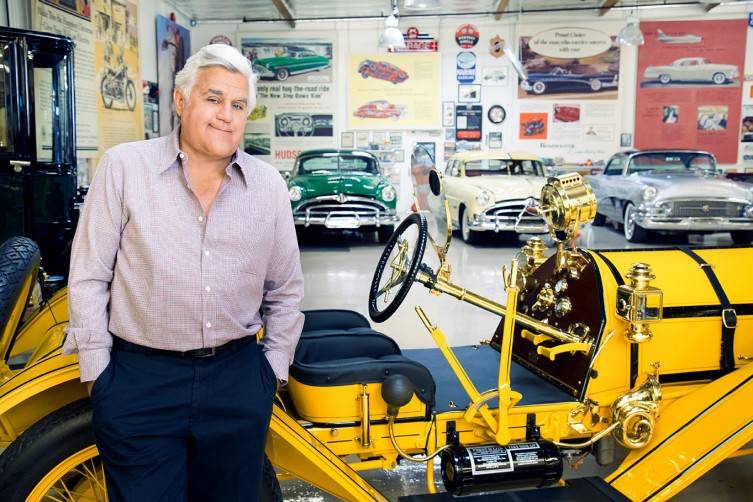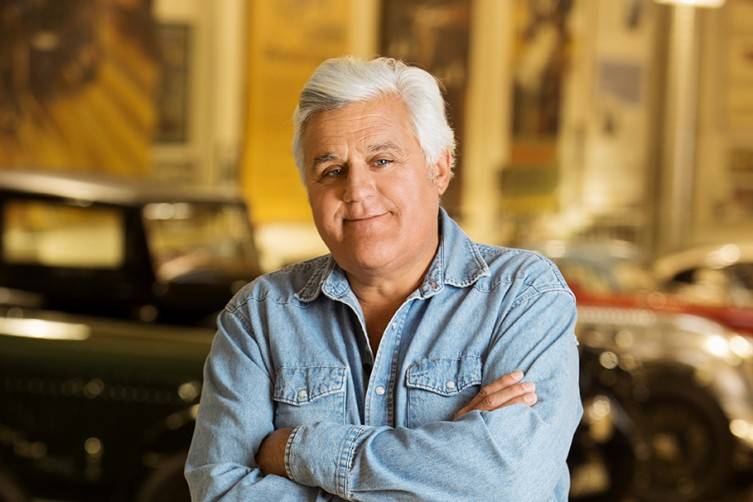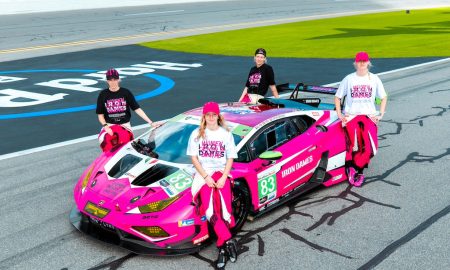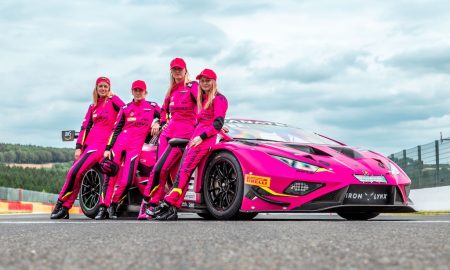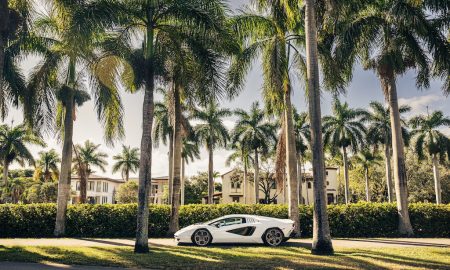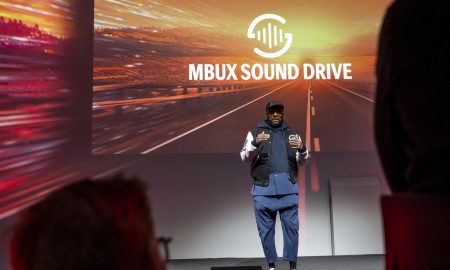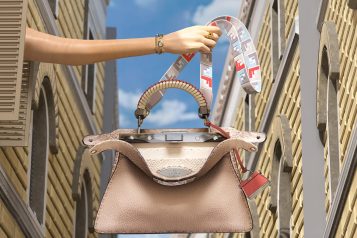With Jay Leno, what you see is what you get. What’s his native habitat and garb? Underneath a vintage car, wearing blue jeans and a blue work shirt. You don’t get much more Average Joe than that. His easy going, extra pleasant personality makes him so comfortable with himself that he’s best-friend-easy in conversation. Not even a touch pretentious, he’s likely the best person you’ll ever share a beer with, especially while discussing cars.
And “cars” is a subject he knows—no—lives and breathes. Given that his stable of vehicles (well over 100 cars and a similar number of motorcycles) includes the widest array imaginable, there’s a lot to know. Want to talk about a Baker Electric Car (made in 1909 in Cleveland)? Ask away. Interested in the Chrysler Turbine car (the 1963 “Car of the Future”)? He knows all about it. How about the McLaren F1 (the ultimate supercar of the ‘90s, worth a king’s ransom today)? Step on up and have a listen. How does it compare to the P1? Let’s park my F1 and my P1 side by side and take a look.
Of course, Leno is best known for hosting The Tonight Show from 1992 to 2009, and again from 2010 to 2014. But, among car aficionados, he’s legendary for his YouTube show, Jay Leno’s Garage, a weekly, web-only cast, where he hosts a new video review of cars and motorcycles every Sunday. And now, Leno is taking that idea of bringing the fast, the beautiful, the obscure—basically the past, present and future of wheels—to primetime in his new show, also tentatively titled Jay Leno’s Garage, premiering this fall on CNBC. As he puts it, “It’s about anything that rolls, explodes or makes noise.”
Leno’s new show will be a paean to the Enzo Ferraris and Ferruccio Lamborghinis; the Henry Fords; the Preston Tuckers; the Walter Chryslers and the Elon Musks, the dreamers and the pragmatists, some of whom were successful in their days, some who still are, and some who went broke misunderstanding or even over-delivering what America wanted at that time. The show will mostly focus on cars located in the U.S., but may venture further in the future. Leno is equally enamored of supercars, muscle cars and electron-motivated vehicles, so expect to see everything from Teslas to BMW i-cars, to Mission or Lightning electric motorcycles on the show, especially after it starts airing on TVs across the country.
JUST A GARAGE THAT GOT OUT OF HAND
Most gearheads know that Leno has one of the most diverse, interesting, exotic, ec- lectic and—okay—occasionally weird collections of cars anywhere, housed in what he calls the “Big Dog Garage.” With approximately 135 cars and about 115 motorcy- cles, it’s certainly prodigious. And adjacent to the series of structures comprising the garage is another huge warehouse, which is devoted to maintaining and even restoring his machines. Lathes turn, drill presses whir, milling machines—you get the idea. This is not some “gentleman’s garage” with everything neat and tidy—it’s a working shop, with equipment large and small, new and old, as well as historic (a few prominent spots are occupied by gigantic steam-powered machines that ran factories). But lest we forget that Leno is a man of his time, his shop also boasts a 3D scanner and two 3D printers.
Leno is so into the gestalt of machines that he’s taught himself how to operate and do some of the routine maintenance on his whole fleet. The older vehicles make sense to him just by looking at them, as if “classic car engineer” is his native tongue. “I always have prided myself on being able to get the thing to do what it’s supposed to without looking at the manual,” he says. “I mean, in a modern car, set the clock by holding the AM button down while putting your foot on the dimmer switch, and turn on the left blinker. It’s not intuitive.” But, Leno is no Luddite, as attested to by his McLarens, Lamborghinis and other modern pinnacles of tech- nology. Watching him scramble under one of his steam cars—like the 1906 Stanley Steamer, 1907 White, or 1925 Doble—and light the pilot to get the burner going, then seeing the joy and pride on his face as he gets it to go, you know that this truly is his passion. But what’s the theme of this assemblage of rolling iron?
Walking amongst the dozens and dozens of cars and bikes, all parked neatly on spotless white floors under spotlights, in a series of interconnecting rooms, it’s hard to discern a pattern. Cars large and small, some really fast, others more pokey. Open-top and closed. Foreign and domestic. What ties them all together? Here’s his clue: “Everything here is registered on the road, and I drive them all. Everything here runs and runs; most of them start on the button, which is kind of fun. These aren’t kinetic artwork; they’re meant to go down the road.” But to Leno, getting there isn’t half the fun; it’s almost all of it. “How I get there is way more important than where I’m going,” he says. And that’s why he’s seen so often driving around Los Angeles: he wants to be on the road, exercising his stable, and feeling the joy of making a decades-old— or even century-old vehicle—strut its stuff, and knowing that he had a part in mak- ing that happen. Just don’t call Leno’s cars a “collection,” a term that causes him to bristle. He prefers “a garage that got out of hand.”
NEVER UNDERESTIMATE THE VALUE OF LOW SELF-ESTEEM
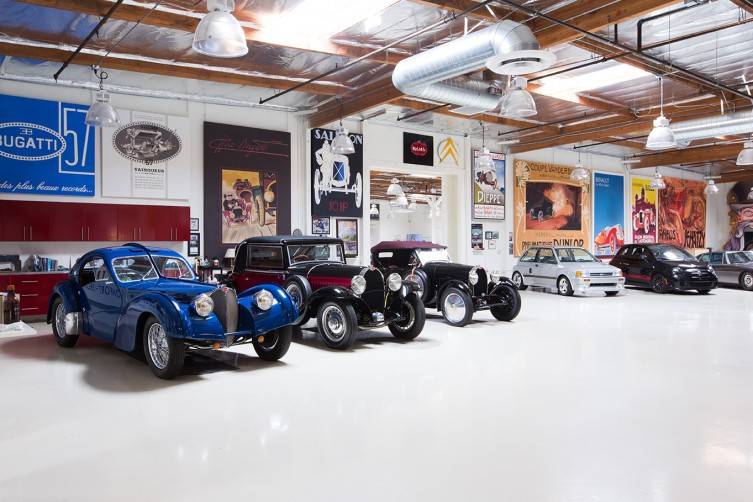
But, how did Leno’s fixation flourish? Let’s step back a bit and examine his roots. Leno’s dad was from a loud Italian family, and his mom emigrated from Scotland with her family when she was 11. His dad sold insurance, starting door-to-door in Harlem, selling policies that cost five cents a week, and part of that job was to walk through the neighborhoods weekly to collect the nickels. Leno’s large and boisterous Italian household gave him major fodder for his stories later in life. His brother, 10 years older and almost a generation apart, was a quiet, intelligent fel- low who was a good student and a somewhat serious sort of guy—more similar to their mom. Sent to military school in his teens, he went on to graduate from Yale Law School, but eventually returned to his roots, selling insurance like his dad had done. Patrick passed away in 2002 from cancer at the age of 62.
Leno admits he was an okay student, but did not learn conventionally, though he didn’t know of a big reason for those struggles until he was diagnosed as dyslexic. His mom did what she could, helping him with homework and with whatever else he needed assistance. His mother was smart, yet not formally educated, and her strong Scottish brogue made some of their dinner table sessions comical—for example, her trying to teach young Jay French, giving him exposure to at least two languages that he couldn’t understand. Yet the turning point in his life really came from his English teacher, Mrs. Hawke, who noticed how teenage Jay periodically held court in the school hallways, telling jokes. Presciently, she suggested that, for his assignments, he should write out his stories on paper and then read them aloud to the class. Bingo! Leno had never enjoyed homework before, but after that, it became a source of great pleasure for him. He was so grateful for her guidance, that he eventually created a scholarship in her name at the school.
Leno lived at home until he left for university at Boston’s Emerson College, from which he graduated in 1973 with a bachelor’s degree in speech therapy. Again presaging what his life would become as the owner of world-class automobiles and motorcycles, Leno got a job at the local Rolls-Royce- Bentley dealer (they typically were the same dealership at that time). “I did new car prep, that’s what I did. I was a kid, you know, putting on license plates, checking the oil. I was a college student at the time. So consequently, I was a little bet- ter equipped to deal with some of the rich customers, as I knew how to talk. They would send me to pick people up and take them around and do whatever; it was primarily…light mechanic work, changing oil and things like that.”
As much as he admired automobiles, comedy was in his veins, so he headed west after college to the joke-and-television capital of the world. But, it wasn’t long before cars started playing a large part in his life again. He bought a 1955 Buick Road master in 1972. He paid $350 for that 17-year-old car. It was the car that
took him and Mavis—his wife of 35 years—on their first date, and it was the car that took him to his first gig with Johnny Carson on The Tonight Show. Though the Buick went somewhat fallow for many years, he still has it, but since the millennium, it now boasts a Corvette engine and a modern chassis setup. So again, we see the ubiquitous themes in Leno’s life—finding something that he enjoys and then sticking with it, making it better, and then relishing it for decades and decades. Side note: Leno never sells his cars, though he’s donated several to charitable causes.
Leno’s been oft-quoted saying “I’m a great believer in low self-esteem. So consequently, if you don’t think you’re the smartest person in the room, and you think you’re going to have to work a little harder and put a little more time into it to get what everybody else does, you can actually do quite well. And that’s been my approach.” Leno can point to several instances where he has used that philosophy. For example, when he was starting out and going to clubs on open-mic nights, Leno would frequently outlast others who stomped off muttering, “I don’t need this.”
PAST AS PROLOGUE
Leno knew that he had to work hard to get ahead. He knew that others had some advantages that he didn’t have, so he had to make use of the talents he did have. Work hard. Persevere. Prepare well. Learn more. Outlast the other guy. Perhaps disarm with humor. Those traits—all of which were both exhibited and espoused by his Italian dad and Scottish mom—made Leno who he is to- day, and have provided him with the resources that he needed to become as successful as he is.
His hard work—coupled with his somewhat self-deprecating demea- nor (it’s not just part of some act)— is what makes him so approachable: everyman’s star. Today, he’s busy with cars and comedy, perhaps in that order. His wonderful marriage to his beloved wife, who shares some of his petrol passions and joins him at many of his car-related events, continues to flourish.
So what’s it like to no longer host a nightly show after doing so for more than two decades? Any sadness or regrets? Well, first, he’s hardly retired. Leno books about 200 speaking events per year, both public and corporate. And here’s something you probably didn’t see coming—Jay Leno and Colin Powell, conversing about world events. It’s the Leno you may not know; the smart, world-wise and politically-savvy guy, on stage with a former four-star general, National Security Advisor and Secretary of State. That’s just classic Leno: he’s entertained us for years, making us laugh—much of the time at ourselves—and informing us too, all the while with a smile and a funny remark, not needing to show us how cerebral he really is. And now, as he enters the next act of his accomplished and interesting life, he does so with class, aplomb, enthusiasm—and, of course, at the wheel of something really, really interesting.
